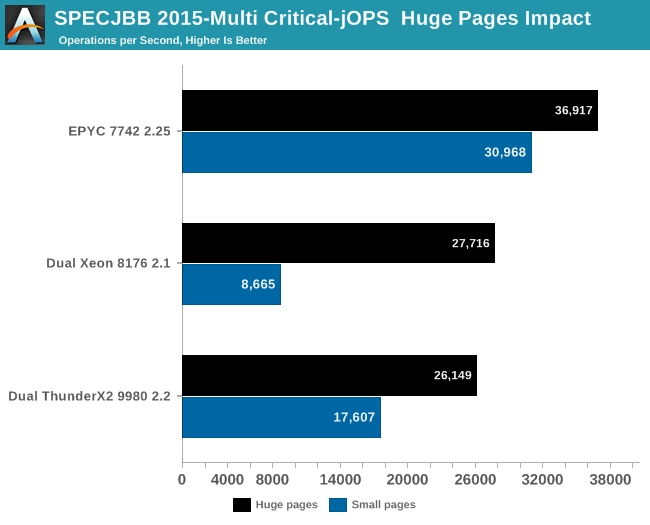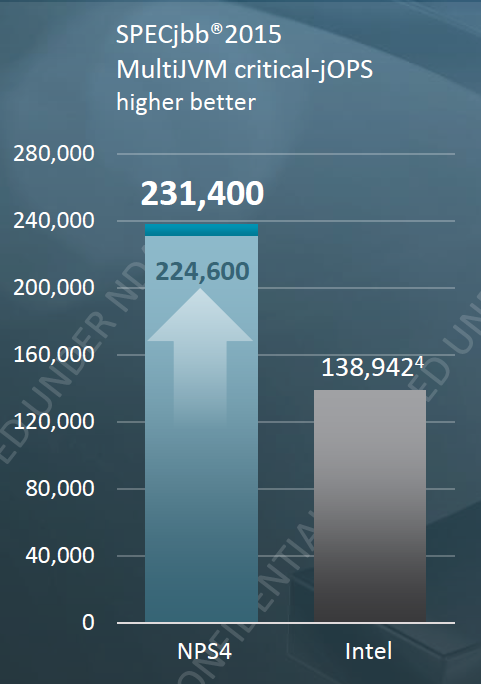AMD Rome Second Generation EPYC Review: 2x 64-core Benchmarked
by Johan De Gelas on August 7, 2019 7:00 PM ESTJava Performance
Even though our testing is not the ideal case for AMD (you would probably choose 8 or even 16 back-ends), the EPYC edges out the Xeon 8176. Using 8 JVMs increases the gap from 1% to 4-5%.
The Critical-jOPS metric is a throughput metric under response time constraint.

With this number of threads active, you can get much higher Critical-jOps by significantly increasing the RAM per JVM. However, we did not want that as this would mean we can not compare with systems that can only accommodate 128 GB of RAM. Notice how badly the Intel system needs huge pages.
The benchmark data of Intel and AMD can be found below.
According to AMD, the EPYC 7742 can be up to 66% faster. However note that these kind of high scores for critical-jOPS are sometimes configured with 1 TB of RAM and more.











180 Comments
View All Comments
schujj07 - Friday, August 9, 2019 - link
The problem is Microsoft went to the Oracle model of licensing for Server 2016/19. That means that you have to license EVERY CPU core it can be run on. Even if you create a VM with only 8 cores, those 8 cores won't always be running on the same cores of the CPU. That is where Rome hurts the pockets of people. You would pay $10k/instance of Server Standard on a single dual 64 core host or $65k/host for Server DataCenter on a dual 64 core host.browned - Saturday, August 10, 2019 - link
We are currently a small MS shop, VMWare with 8 sockets licensed, Windows Datacenter License. 4 Hosts, 2 x 8 core due to Windows Licensing limits. But we are running 120+ majority Windows systems on those hosts.I see our future with 4 x 16 core systems, unless our CPU requirements grow, in which case we could look at 3 x 48 or 2 x 64 core or 4 x 24 core and buy another lot of datacenter licenses. Because we already have 64 cores licensed the uplift to 96 or 128 is not something we would worry about.
We would also get a benefit from only using 2, 3, or 4 of our 8 VMWare socket licenses. We could them implement a better DR system, or use those licenses at another site that currently use Robo licenses.
jgraham11 - Thursday, August 8, 2019 - link
so how does it work with hyper threaded CPUs? And what if the server owner decides to not run Intel Hyperthreading because it is so prone to CPU exploits (most 10 yrs+ old). Does Google still pay for those cores??ianisiam - Thursday, August 8, 2019 - link
You only pay for physical cores, not logical.twotwotwo - Thursday, August 8, 2019 - link
Sort of a fun thing there is that in the past you've had to buy more cores than you need sometimes: lower-end parts that had enough CPU oomph may not support all the RAM or I/O you want, or maybe some feature you wanted was absent or disabled. These seem to let you load up on RAM and I/O at even 8C or 16C (min. 1P or 2P configs).Of course, some CPU-bound apps can't take advantage of that, but in the right situation being able to build as lopsided a machine as you want might even help out the folks who pay by the core.
azfacea - Wednesday, August 7, 2019 - link
FNikosD - Wednesday, August 7, 2019 - link
Ok guys...The Anandtech's team had a "bad luck and timming issues" to offer a true and decent review of the Greatest x86 CPU of all time, so for a proper review of EPYC Rome coming from the most objective and capable site for servers, take a look here:https://www.servethehome.com/amd-epyc-7002-series-...
anactoraaron - Thursday, August 8, 2019 - link
Fphoenix_rizzen - Saturday, August 10, 2019 - link
Review article for new CPU devolves into Windows vs Linux pissing match, completely obscuring any interesting discussion about said hardware. We really haven't reached peak stupid on the internet yet. :(The Benjamins - Wednesday, August 7, 2019 - link
Can we get a C20 benchmark for the lulz?